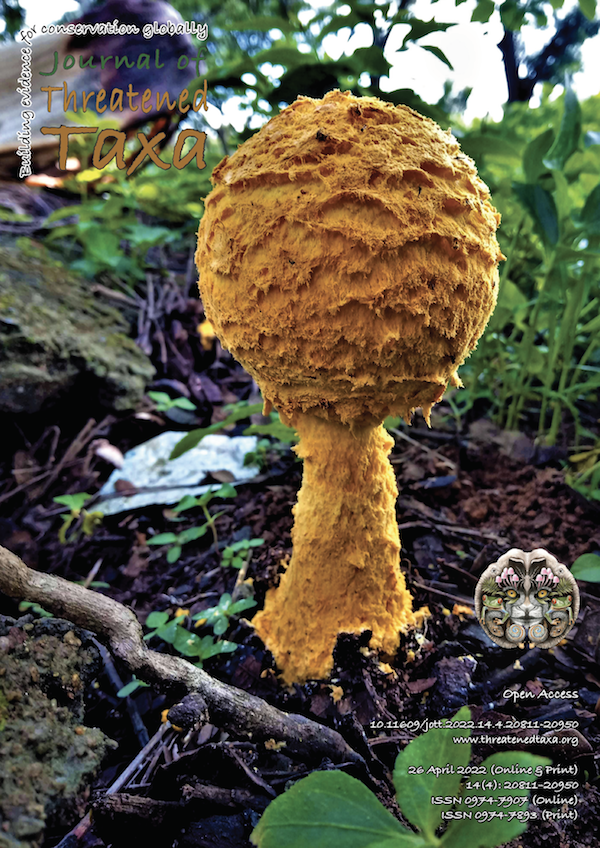Reproductive biology of two threatened and highly traded medicinal plants, Salacia gambleana and Salacia oblonga, from the Western Ghats of India
Main Article Content
Abstract
Salacia is a genus of flowering plants in the family Celastraceae, consisting of woody climbers distributed in tropical America, Africa, and Asia. In India it is represented by 21 species, of which 15 occur in peninsular India. Most species of the genus have been used in traditional medicine, mainly the Ayurvedic system. Apart from overexploitation for medicinal purposes, the low fruit set and infestation of seeds have affected natural regeneration, and led to the rarity of Salacia species in their natural habitats. The reproductive biology of Salacia oblonga and S. gambleana was studied for the first time to understand the reproductive constraints of these threatened and medicinally important species. The flowering phenology, pollen viability, germination, stigma receptivity, and insect-pest interaction were analyzed. The obligatory entomophily coupled with insufficient pollinators and seed pest infestation were found to be the main reproductive constraints responsible for the low fruit set and poor natural regeneration of these species.
Article Details

This work is licensed under a Creative Commons Attribution 4.0 International License.
Authors own the copyright to the articles published in JoTT. This is indicated explicitly in each publication. The authors grant permission to the publisher Wildlife Information Liaison Development (WILD) Society to publish the article in the Journal of Threatened Taxa. The authors recognize WILD as the original publisher, and to sell hard copies of the Journal and article to any buyer. JoTT is registered under the Creative Commons Attribution 4.0 International License (CC BY), which allows authors to retain copyright ownership. Under this license the authors allow anyone to download, cite, use the data, modify, reprint, copy and distribute provided the authors and source of publication are credited through appropriate citations (e.g., Son et al. (2016). Bats (Mammalia: Chiroptera) of the southeastern Truong Son Mountains, Quang Ngai Province, Vietnam. Journal of Threatened Taxa 8(7): 8953–8969. https://doi.org/10.11609/jott.2785.8.7.8953-8969). Users of the data do not require specific permission from the authors or the publisher.
References
Cruden, R.W. (1977). Pollen-ovule ratios- A conservative indicator of breeding system in flowering plants. Evolution 31: 32–46.
Dafni, A., P.G. Kevan & B.C. Husband (eds.) (2005). Practical pollination biology. Enviroquest Ltd, Canada, 590 pp.
Gopalakrishnan, K.K. & T.D. Thomas (2014). Reproductive biology of Pittosporum dasycaulon Miq. (Family Pittosporaceae), a rare medicinal tree endemic to Western Ghats. Botanical Studies 55(1): 15.
Gómez, J.M., R. Zamora, J.A. Hódar & D. García (1996). Experimental study of pollination by ants in Mediterranean high mountain and arid habitats. Oecologia 105: 236–242.
Jose, P.A., A.G. Pandurangan & G. Mathew (2004). Impact of insect-pest incidence on natural populations of Gluta travancorica Bedd.-A rare and endemic tree species of the Southern Western Ghats, India. Journal of Non-Timber Forest Products 11(2): 99–102.
Jose, P.A. & A.G. Pandurangan (2012). Reproductive biology of Ochreinauclea missionis (Wall. ex G.Don) Ridsd. An endemic and vulnerable tree from the Western Ghats, India. Annals of Forestry 20(2):161–167.
Jose, P.A. & A.G. Pandurangan (2013). Reproductive biology of Gluta travancorica Bedd., An endemic and threatened tree from the Southern Western Ghats, India. Annals of Forestry 21(2):165–171.
Jose, P.A., S.T. Kuruvila & N.M. Binoy (2016). New record of seed Pest, Alcidodessp. indet. (Coleoptera: Curculionidae) in Cynometra beddomei Prain.- An endemic, endangered legume tree of the Southern Western Ghats. Indian Journal of Forestry 39(2): 133–135.
Kempel, A., H. Vincent, D. Prati & M. Fischer (2020). Context dependency of biotic interactions and its relation to plant rarity. Diversity and Distributions 26: 758–768. https://doi.org/10.1111/ddi.13050
Kirtikar, K.R. & B.D. Basu (1975). Indian Medicinal Plants – Vol. 1. M/S Bishen Singh Mahendra Pal Singh, 754 pp.
Krishnakumar, K., K.T. Augusti & P.L. Vijayammal (2000). Anti-peroxidative and hypoglycaemic activity of Salacia oblonga extract in diabetic rats. Pharmaceutical Biology 38(2): 101–105.
Kudon, H. & D.F. Whigham (1998). The effect of petal size manipulation on pollinator/seed-predator mediated female reproductive success of Hibiscus moscheutos. Oecologia 117(1–2): 70–79.
Prakah, P.M., L.J. Patil & S.A. Thanga (2008). Genus Salacia: a comprehensive review. Journal of Natural Remedies 8(2): 116–131.
Rathcke, B. & E.P. Lacey (1985). Phenological patterns of terrestrial plants. Annual Review of Ecology and Systematics 16(1): 179–214.
Reveal, J.L. (1981). The concepts of rarity and population threats in plant communities, pp. 41–47. In: Morse, E.L. & M.S.Henifin (eds.). Rare Plant Conservation. Geographical Data Organization, New York., 377 pp.
Rostás, M. & J. Tautz (2010). Ants as Pollinators of Plants and the Role of Floral Scents. Springer, Dordrecht, 590 pp.
Sasidharan, N. (2017). A Handbook on the Red listed species and their conservation status in Kerala. Final Technical Report. Kerala Forest Research Institute, Peechi, 527 pp.
Shivanna, K.R. & N.S. Rangaswamy (1992). Pollen Biology- A Laboratory Manual. New Springer, 122 pp.
Sreekala, A.K., A.G. Pandurangan, R. Ramasubbu & S.K. Kulloli (2008). Reproductive Biology of Impatiens coelotropis Fischer, a critically endangered balsam from the Southern Western Ghats. Current Science 95: 386–388.
Subin, K., P.A. Jose & T.V. Sarath (2018). On the reproductive biology of Salacia fruticosa Wall. ex M.A. Lawson - an endemic medicinal plant of the Western Ghats, India. Journal of Threatened Taxa 10(15): 13002–13005. https://doi.org/10.11609/jott.3069.10.15.13002-13005
Swarupanandan, K., E.P. Indira, E.M. Muralidharan, R.C. Pandalai & P.A. Jose (2013). Species recovery of Dipterocarpus bourdillonii and Humboldtia bourdillonii, two critically endangered endemic trees of Western Ghats, Kerala Forest Research Institute, Research Report No. 463, 86 pp.
Tsuji, K., A. Hasyim, H. Nakamura & K. Nakamura (2004). Asian weaver ants, Oecophylla smaragdina, and their repelling of pollinators. Ecological Research 19(6): 669–673. https://doi.org/10.1111/j.1440-1703.2004.00682.x
Ved, D., D. Saha, K. Ravikumar & K. Haridasan (2015). Salacia oblonga. The IUCN Red List of Threatened Species 2015. https://doi.org/10.2305/IUCN.UK.2015-2.RLTS.T50126639A50131425.en
Wang, J., X. Rong, W. Li, J. Yamahara & Y. Li (2012). Salacia oblonga ameliorates hypertriglyceridemia and excessive ectopic fat accumulation in laying hens. Journal of Ethnopharmacology 142(1): 221–227.

